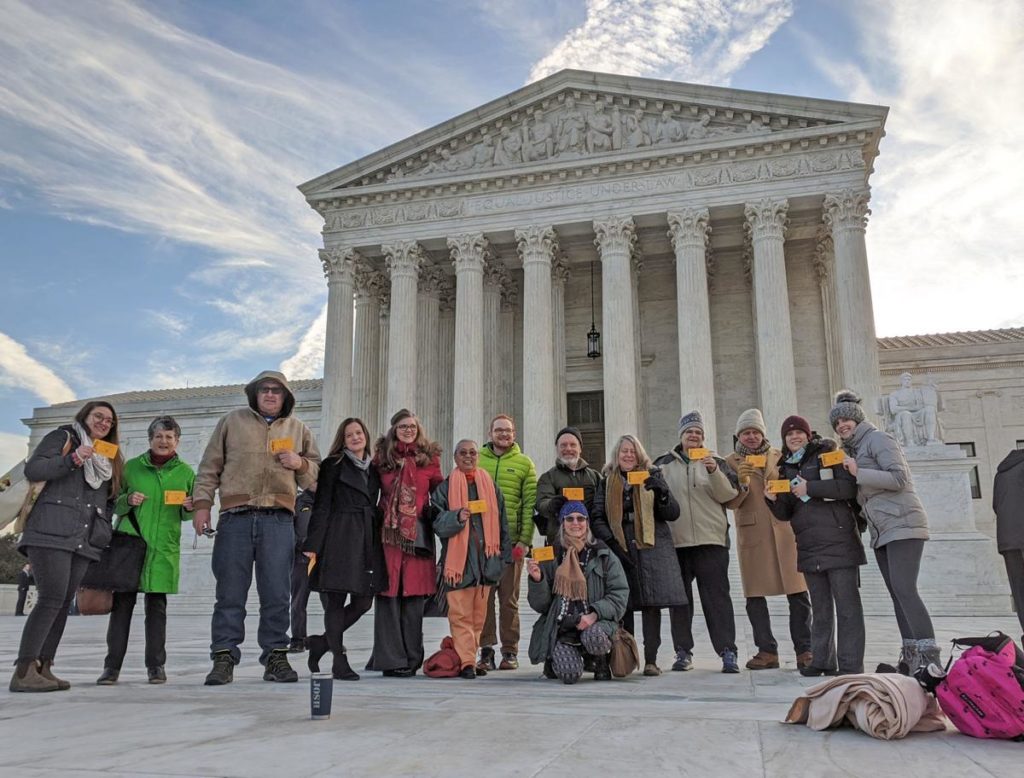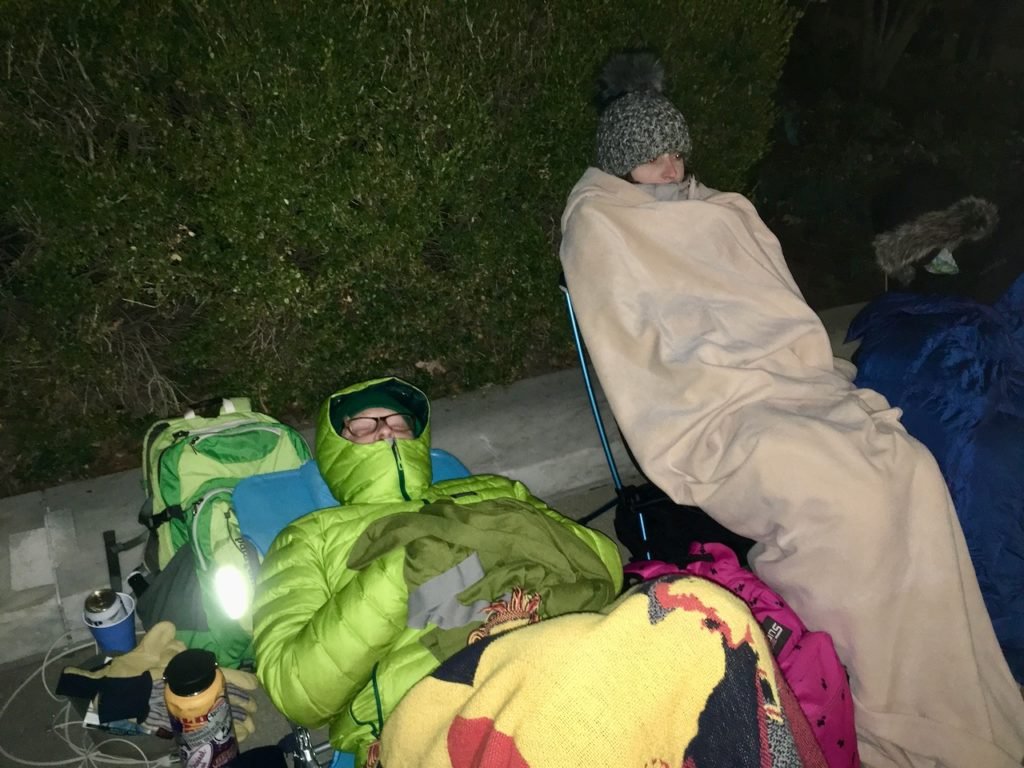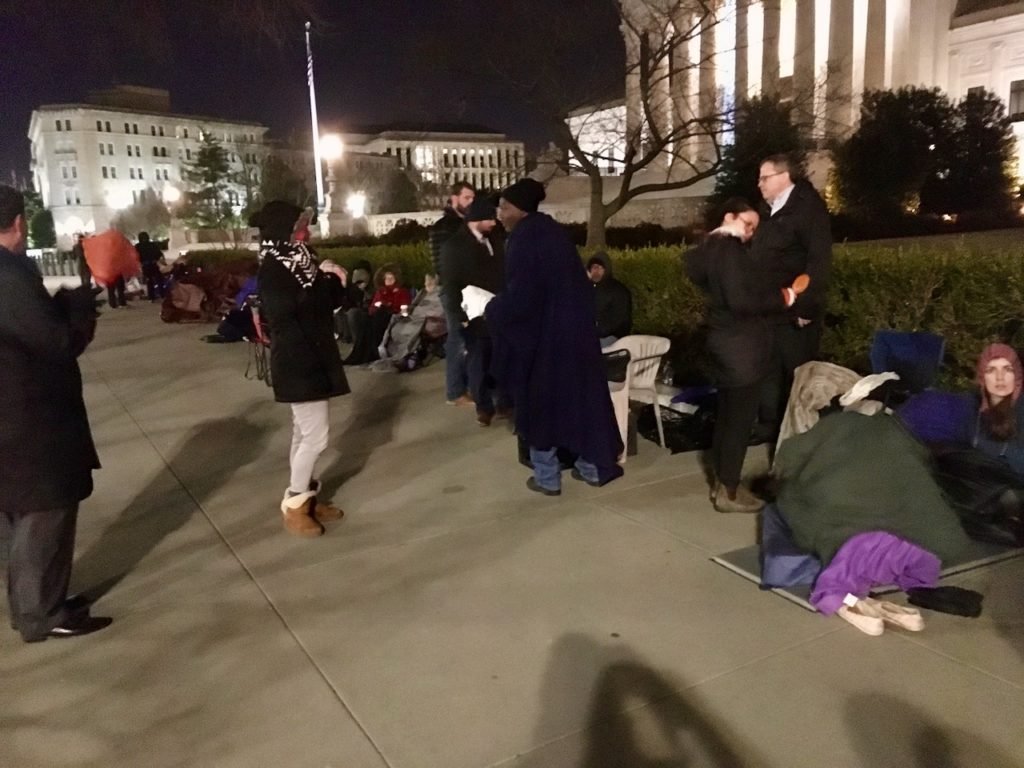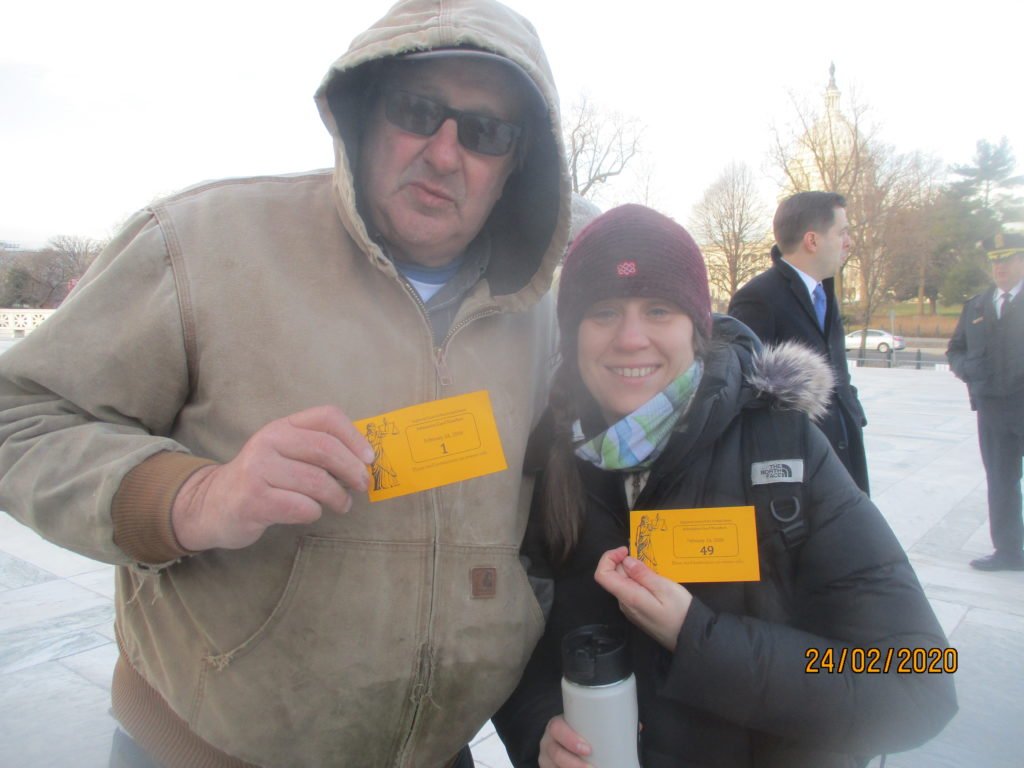Uplifted Standing In Line at SCOTUS

Fourteen of the lucky 50 with their golden tickets to get into the courtroom of the Supreme Court of the United States. Maury Johnson is third from the left. I am third from the right next to Nancy Sorrells. Photo courtesy Nancy Sorrells.
I Was In Line All Night, Here’s What Really Happened
It was an event of a lifetime—sitting in the courtroom of the Supreme Court of the United States (SCOTUS) hearing arguments in the U.S. Forest Service v. Cowpasture River case on Monday, February 24—the case that will determine if a dirt path, known as the Appalachian Trail, is actually “land” or not. For me, the most uplifting part of the whole event was the people standing in line for hours outside the courthouse, in near-freezing temperatures, waiting to hear the case that will weigh heavily on the lives of thousands forever. Maury Johnson, pipeline fighter and farmer from Monroe County, West Virginia, was first in line arriving at 6:30 Sunday night. The determination and leadership of these folks inspire me and so many others. The true grit of these people and thousands more like them is the reason the Atlantic Coast Pipeline will never be built.
They Only Allow 50 People In
I was asleep in bed at a friend’s house in Arlington, Virginia. I received a group text at 10:30 p.m. from my friend Carolyn who was in line. She wrote that we had better come if we wanted to get in to hear the case. She was 36 in line. They only let 50 people in.
“I’m en route,” I texted back.
My friend Roni drove me to the Supreme Court building, and we arrived at 11 p.m. As soon as I saw the people in line, I knew I was not prepared for an all-nighter in the cold. They had chairs, sleeping bags, blankets, and tarps. I had the knee pad I use in the garden, an overcoat, my gloves, and a wool cap. Folks from the Southern Environmental Law Center, the Alliance for the Shenandoah Valley, Friends of Buckingham, and the Sierra Club welcomed me with open arms. I immediately went to the end of the line, put my knee pad down on the sidewalk and declared to the group that this was my spot. Counting from the beginning of the line and if no one butted in, I would be the 45th person.

Some of the more prepared anti-pipeline fighters in line on the sidewalk in front of the Supreme Court. Photo courtesy R. Whitescarver.
“Equal Justice Under the Law.” Yeah, Right.
There were two kinds of people in line that frigid night: the pipeline fighters and the homeless folks of D.C. hired by a professional “line-standing” company to stand in line for the pro-pipeline people. Pro-pipeline people from Dominion Energy and their allies didn’t start arriving until the next morning at 5:30. They rolled in curbside in their high-dollar suits, freshly brushed teeth, clean-shaven faces, and pretty hair.
They coordinated with a woman who had a clipboard standing on the corner of First Street and East Capitol. She escorted them to the homeless people line-standing for them all through the frigid night. The corporate rich people handed money to the homeless people and then took their place in line. I looked up at the words on the Supreme Court building, “Equal Justice Under the Law,” and felt betrayed.

The lady in the white pants holds a clipboard. She is escorting pro-pipeline people that paid to have homeless folks “line-sit” for them. Photo courtesy R. Whitescarver.
People trickled in all through the night, and the line grew to well over 100 people. By my estimate, 60 percent of the people in line appeared to be homeless people hired by the line-standing company. Most of them reclined in their chair and covered their whole body with a tarp.
This behavior—of beating the system any way possible, buying people off, and flaunting their power and money in the faces of the common people, whom they walk over and whose dreams they steal—is why people are standing up to them, resisting, and fighting. This is why the Atlantic Coast Pipeline will never be built.
Upbeat and Positive
The anti-pipeline people were in clusters of three to four scattered through the line. They were cold yet upbeat, positive, talkative, and very helpful. There are no bathrooms on the premises. Union Station is about five blocks away, but we learned they lock their toilets until 5 a.m. There is a 7-Eleven five blocks away that stays open all night. Oh, thank heaven.
We all guarded each other’s place in line as some left for the 7-Eleven or simply walked around to keep warm. I walked around a lot. I’ll never forget the image of Maury Johnson sitting in his chair at position number one. He’s a big guy. He was in his farmer clothes, and the only coat he had was a lightweight Carhartt jacket. He wore a red plastic poncho over his body and chair.
I’ll also never forget the kindness of my line-mate Julie Reynolds-Engle. She gave me a couple of hand warmers that I put in my boots to keep my feet from getting numb.
The Golden Tickets
The police started walking the sidewalk around us at about 7:00 in the morning. Our line tightened up, and I watched for people butting in line. A policeman started handing out the coveted golden tickets with your number on it. I braced for disappointment. He finally arrived and handed me a ticket—49. Four people had butted in line.
The lucky 50 moved to the next level, closer to the building. A young lady I met during the night, Laura LeFleur (ticket 36), asked me if I would switch with her so she could be with her friend, Julie (48). I agreed and we switched tickets. We took some pictures then moved to the entrance to the left of the tall columns. There we received our first lecture and then proceeded into the building and through the first security checkpoint.
Once through security, we put our personal items in lockers and waited in the cafeteria for instructions to proceed upstairs. At about 9:10 we were instructed to line up against a wall outside the cafeteria in numerical order. After about a half-hour, we proceeded up the stairs to the courtroom level. There we received another lecture and then proceeded into the foyer through another security checkpoint.
“The Trail Is Not Land”
We were escorted into the courtroom and seated. “Oyez, oyez, oyez,” the marshal of the court called out, and the proceeding began. It was an hourlong event. Each justice was engaged and asked questions, with the exception of Justice Clarence Thomas who didn’t say a single word. I didn’t think there was a clear winner or loser but the strangest claim was the Forest Service lawyer’s argument that the dirt path of the Appalachian Trail was not land. “The trail is not land,” he said over and over.
“Nobody makes that distinction in real life,” Justice Elena Kagan stated.
Read the entire transcript of the argument U.S. Forest Service v. Cowpasture River Preservation Association.
I did not know until after the argument that my friends Julie (48) and Laura (49) did not get in. For some reason, the court stopped letting people in after 47. My heart sank. They stood in the cold the whole night to no avail.
“Equal Justice Under the Law?” I don’t think so.

Maury Johnson and Laura LeFleur with their golden tickets. Laura switched with me to be with her friend Julie. Laura and Julie never made it in. Photo courtesy Maury Johnson.
Changes Needed
Contact your legislators and demand that they stop the exchange of money for line-standing at the Supreme Court. Buying your way into court is not right.
And that’s not the only thing wrong with the system. People should have designated places in line so there is no guesswork, restroom facilities should be provided, smoking should not be permitted in line, and police should patrol the sidewalk. Why only 50 people? Why not televise it?
The Fate of the ACP
As for the fate of the Atlantic Coast Pipeline, there are seven other permits that have been vacated or withdrawn for the un-needed, over-budget, an ill-planned pipeline. In addition, there are hundreds, perhaps thousands of people joining the ranks of pipeline fighters.
The Atlantic Coast Pipeline will never be built.
For the latest update on the ACP visit the Allegheny Blue Ridge Alliance website.
The post Uplifted Standing In Line at SCOTUS appeared first on Getting More on the Ground.


